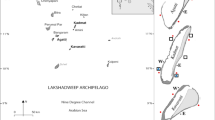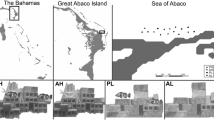Abstract
Here I investigate whether patterns of scarid biomass across the continental shelf of the northern Great Barrier Reef can be explained by species associating with particular characteristics of the reef environment. Despite the widely documented tendency of scarids to graze and browse over exposed calcareous reef surfaces, scarid biomass was not significantly correlated with the availability of feeding substrata for any species investigated. Indeed positive correlations between biomass and substrata variables were rare for the 18 species investigated, indicating that biomass in these taxa was not strongly reliant on the availability of preferred substrata quantified at the spatial scale of sites (1620 m2). Rather, species specific biomass was commonly highly variable between sites, suggesting that local aggregation of scarids commonly occurs at this scale. Such spatial patchiness potentially reflects the effects of spatially variable recruitment, fishes associating with unmeasured habitat characteristics or aggregating prior to spawning. Despite variability in the biomass of individual species between replicate sites within exposure regimes, exposure was generally a far more reliable predictor of biomass than the other variables quantified. This study provides little evidence to indicate that adult scarids have strict habitat requirements, rather they appear to be habitat generalists whose biomass is strongly influenced by exposure but weakly related to the cover of particular reef substratum.
Similar content being viewed by others
References cited
Aiken, L. S. & S.G. West. 1991. Multiple regression: testing and interpreting interactions. Sage Publications, London. 212 pp.
Alcala, A. & G.R. Russ. 1990. A direct test of the effects of protective management on abundance and yield of tropical marine resources. J. Cons. Int. Explor. Mer. 46: 40–47.
Bell, J.D. & R. Galzin. 1984. Influence of live coral cover on coral reef fish communities. Mar. Ecol. Prog. Ser. 15: 265–274.
Bell, J.D., G.J.S. Craik, D.A. Pollard & B.C. Russell. 1985. Estimating length frequency distributions of large reef fish underwater. Coral Reefs 4: 41–44.
Bellwood, D.R. 1988. Ontogenetic changes in the diet of early post-settlement Scarus species (Pisces: Scaridae). J. Fish Biol. 33: 213–219.
Bellwood, D.R. & A.C. Alcala. 1988. The effect of a minimum length specification on visual estimates of density and biomass of coral reef fishes. Coral Reefs 7: 23–27.
Bellwood, D.R. & J.H. Choat. 1989. A description of the juvenile colour patterns of 24 parrotfish species (family Scaridae) from the Great Barrier Reef, Australia. Rec. Aust. Mus. 41: 1–41.
Booth, D.J. & G. Beretta. 1994. Seasonal recruitment, habitat associations and survival of pomacentrid reef fish in the United States Virgin Islands. Coral Reefs 13: 81–89.
Bouchon-Navaro, Y. & C. Bouchon. 1989. Correlations between Chaetodontid fishes and coral communities of the Gulf of Aqaba (Red Sea). Env. Biol. Fish. 25: 47–60.
Bruggemann, J.H., J. Begeman, E.M. Bosma, P. Verburg & A.M. Breeman. 1994. Foraging by the stoplight parrotfish Sparisoma viride. II. Intake and assimilation of food, protein and energy. Mar. Ecol. Prog. Ser. 106: 57–71.
Carpenter, K.E., R.I Miclat, V.D Albaladejo & V.T Corpuz. 1984. The influence of substrate structure on the local abundance and diversity of Philippine reef fishes. Proc. Int. Coral Reef Symp. 4(2): 497–502.
Choat, J.H. 1991. The biology of herbivorous fishes on coral reefs. pp. 120–155. In: P.F. Sale (ed.) The Ecology of Fishes on Coral Reefs, Academic Press, San Diego.
Choat, J.H & D.R. Bellwood. 1985. Interactions amongst herbivorous fishes on a coral reef: influence of spatial variation. Mar. Biol. 89: 221–234.
Choat, J.H. & K.D. Clements. 1998. Vertebrate herbivores in marine and terrestrial environments: a nutritional ecology perspective. Ann. Rev. Ecol. Syst. 29: 375–403.
Choat, J.H. & J.E. Randall. 1986. A review of the parrotfishes (family Scaridae) of the Great Barrier Reef of Australia with description of a new species. Rec. Aust. Mus. 38: 175–228.
Choat, J.H. & D.R. Robertson. 1975. Protogynous hermaphroditism in fishes of the family Scaridae. pp. 263–283. In: R. Reinboth (ed.) Intersexuality in the Animal Kingdom, Springer Verlag, Berlin.
Clarke, R.D. 1977. Habitat distribution and species diversity of chaetodontid and pomacentrid fishes near Bimini, Bahamas. Mar. Biol. 40: 277–289.
Done, T.J. 1982. Patterns in the distribution of coral communities across the central Great Barrier Reef. Coral Reefs 1: 95–107.
Ferry, R.E. & C.C. Kohler. 1987. Effects of trap fishing on fish populations inhabiting a fringing coral reef. N. Amer. J. Fish. Manage. 7: 580–588.
Findley, J.S. & M.T. Findley. 1985. A search for pattern in butterfly communities. Amer. Nat. 1126: 800–816.
Frith, C.A., J.M. Leis & B. Goldman 1986. Currents in the Lizard Island region of the Great Barrier Reef Lagoon and their relevance to potential movements of larvae. Coral Reefs 5: 81–92.
Galzin, R. 1987. Structure of fish communities of French Polynesian coral reefs. 1. Spatial scales. Mar. Ecol. Prog. Ser. 41: 129–136.
Green, A.L. 1996. Spatial, temporal and ontogenetic patterns of habitat use by coral reef fishes (family Labridae). Mar. Ecol. Prog. Ser. 133: 1–11.
Gust, N., J.H. Choat & M. McCormick. 2001. Spatial variability in reef fish distribution, abundance, size and biomass: a multi-scale analysis. Mar. Ecol. Prog. Ser 214: 237–241.
Hart, A.M. 1996. Response of herbivorous reef fish to outbreaks of crown of thorns starfish, with particular emphasis on the brown surgeonfish (Acanthurus nigrofuscus). Ph.D. Thesis, James Cook University, Townsville. 170 pp.
Hourigan, T.F. 1989. Environmental determinants of butterfly fish social systems. Env. Biol. Fish. 24: 61–78.
Hourigan, T.F., T.C. Tricas & E.S. Reese. 1988. Coral reef fishes as indicators of environmental stress in coral reefs. pp. 107–136. In: D.F. Soule & G.S. Keppel (ed.) Marine Organisms as Indicators, Springer Verlag, New York.
James F.C. & C.E. McCulloch. 1990. Multivariate analysis in ecology and systematics: panacea or Pandora's box? Ann. Rev. Ecol. Syst. 21: 129–166.
Jennings, S., E.M. Grandcourt & N.V.C. Polunin. 1995. The effects of fishing on the diversity, biomass and trophic structure of Seychelles fish communities. Coral Reefs 14: 225–235.
Jennings, S., D.P. Boulle & N.V.C. Polunin. 1996. Habitat correlates of the distribution and biomass of Seychelles' reef fishes. Env. Biol. Fish. 46: 15–25.
Jones, G.P. 1991. Post recruitment processes in the ecology of coral reef fish populations: a multi-factorial perspective. pp. 294–328 In: P.F. Sale (ed.) The Ecology of Fishes on Coral Reefs, Academic Press, San Diego.
Jones, G.P. & C. Syms. 1998. Disturbance, habitat structure and the ecology of fishes on coral reefs. Aust. J. Ecol. 23: 287–297.
Kaufman, L.J. & J.P. Ebersole. 1984. Micro-topography and the organisation of two assemblages of coral reef fishes in the West Indies. J. Exp. Mar. Biol. Ecol. 78: 253–268.
Luckhurst, B.E. & K. Luckhurst. 1978. Analysis of the influence of the substrata variables on coral reef fish communities. Mar. Biol. 49: 317–323.
Munday, P.L., G.P. Jones & M.J Caley. 1997. Habitat specialisation and the distribution and abundance of coral dwelling gobies. Mar. Ecol. Prog. Ser. 152: 227–239.
Ohman, M.C. & A. Rajasuriya. 1998. Relationships between habitat structure and fish communities on coral and sandstone reefs. Env. Biol. Fish. 53: 19–31.
Quinn, G. & M. Keough. 2001. Experimental design and data analysis for biologists. Cambridge University Press, Cambridge. 520 pp.
Randall, J.E., G.R. Allen & R.C. Steene. 1997. Fishes of the Great Barrier Reef and Coral Sea, 2nd edition. Crawford House Publishing, Bathurst.
Richardson, D.L. 1999. Correlates of environmental variables with patterns in the distribution and abundance of two anemone fishes (Pomacentridae: Amphiprion) on an eastern Australian sub-tropical reef system. Env. Biol. Fish. 55: 255–263.
Roberts, C.M. & R.F.G. Ormond. 1987. Habitat complexity and coral reef fish diversity and abundance on Red Sea fringing reefs. Mar. Ecol. Prog. Ser. 41: 1–8.
Robertson, D.R., N.V.C. Polunin & K. Leighton. 1979. The behavioural ecology of three Indian Ocean surgeonfishes (Acanthurus lineatus, A. leucosternon and Zebrasoma scopas): their feeding strategies and social and mating systems. Env. Biol. Fish. 4: 125–170.
Russ, G. 1984a. Distribution and abundance of herbivorous grazing fishes in the central Great Barrier Reef. I. Levels of variability across the entire continental shelf. Mar. Ecol. Prog. Ser. 20: 23–34.
Russ, G. 1984b. Distribution and abundance of herbivorous grazing fishes in the central Great Barrier Reef. II. Patterns of zonation of mid shelf and outer shelf reefs. Mar. Ecol. Prog. Ser. 20: 35–44.
Russ, G.R. & A.C. Alcala. 1989. Effects of intense fishing pressure on an assemblage of coral reef fishes. Mar. Ecol. Prog. Ser. 56: 13–27.
Sale, P.F., J.A. Guy & W.J. Steel. 1994. Ecological structure of assemblages of coral reef fishes on isolated patch reefs. Oecol. 98: 83–99.
Samoilys, M. & G. Carlos. 2000. Determining methods of underwater visual census for estimating the abundance of coral reef fishes. Env. Biol. Fish. 57: 289–304
Sano, M., M. Shimizu & Y. Nose. 1987. Long term effects of destruction of hermatypic corals by Acanthaster planci infestation on reef fish communities at Iriomote Island, Japan. Mar. Ecol. Prog. Ser. 37: 191–199.
Sokal, R.R., & F.J. Rohlf. 1995. Biometry, 3rd edition. W.H. Freeman & Co., New York.
Thresher, R.E. 1983. Environmental correlates of the distribution of planktivorous fishes in the One Tree Reef Lagoon. Mar. Ecol. Prog. Ser. 10: 137–145.
Tolimieri, N. 1998a. Contrasting effects of microhabitat use on large-scale adult abundance in two families of Caribbean reef fishes. Mar. Ecol. Prog. Ser. 167: 227–239.
Tolimieri, N. 1998b. Effects of substrate, resident conspecifics and damselfish on the settlement and recruitment of the stoplight parrotfish, Sparisoma vivide. Env. Biol. Fish. 53: 393–404.
Veron, J.E.N. 1986. Corals of Australia and the Indo-Pacific. University of Hawaii Press, Honolulu. 644 pp.
Warner, R.R. 1988. Traditionality of mating site preferences in a coral reef fish. Nature 335: 719–721.
Wellington, G.M. 1992. Habitat selection and juvenile persistence control the distribution of two closely related Caribbean damselfishes. Oecologia 90: 500–508.
Williams, D.M. 1982. Patterns in the distribution of fish communities across the central Great Barrier Reef. Coral Reefs 1: 35–43.
Williams, D.M. 1991. Patterns and processes in the distribution of coral reef fishes. pp 437–474. In: P.F. Sale (ed.) The Ecology of Fishes on Coral Reefs, Academic Press, San Diego.
Williams, D.M. & A.I. Hatcher. 1983. Structure of fish communities on outer slopes of inshore, mid shelf and outer shelf reefs of the Great Barrier Reef. Mar. Ecol. Prog. Ser. 10: 239–250.
Williams, D.M., G.R. Russ & P. Doherty. 1986. Reef fishes: large scale distribution and recruitment. Oceanus 29: 76–82.
Author information
Authors and Affiliations
Rights and permissions
About this article
Cite this article
Gust, N. Scarid Biomass on the Northern Great Barrier Reef: The Influence of Exposure, Depth and Substrata. Environmental Biology of Fishes 64, 353–366 (2002). https://doi.org/10.1023/A:1016112312009
Issue Date:
DOI: https://doi.org/10.1023/A:1016112312009




